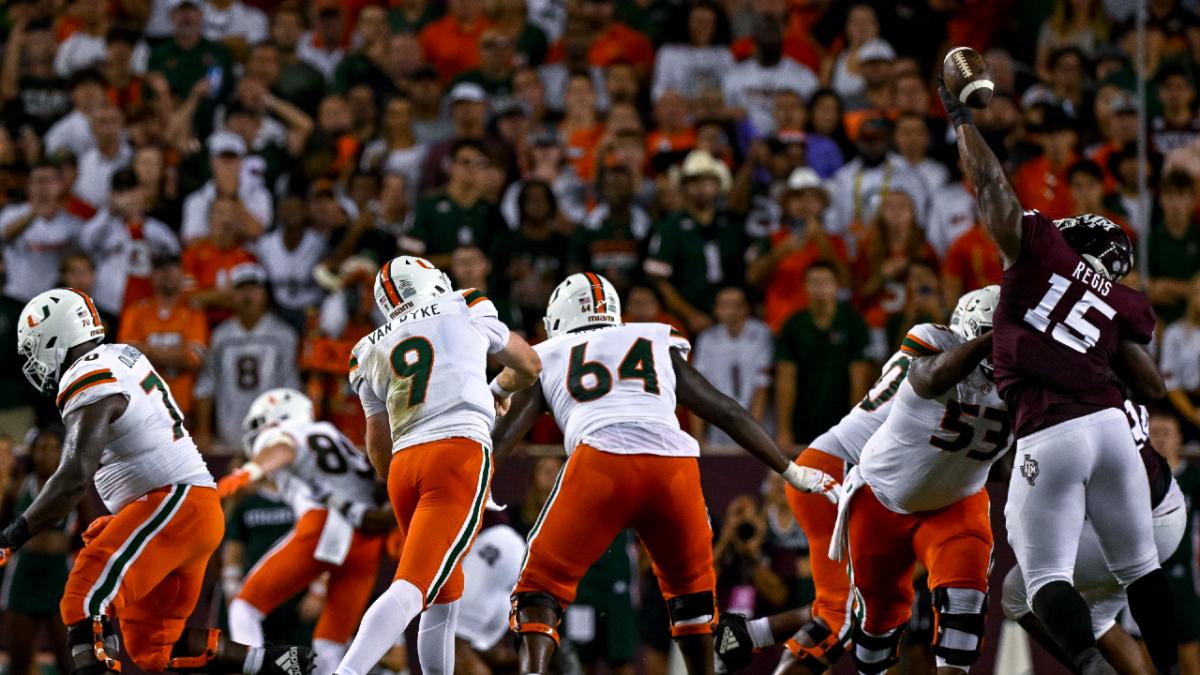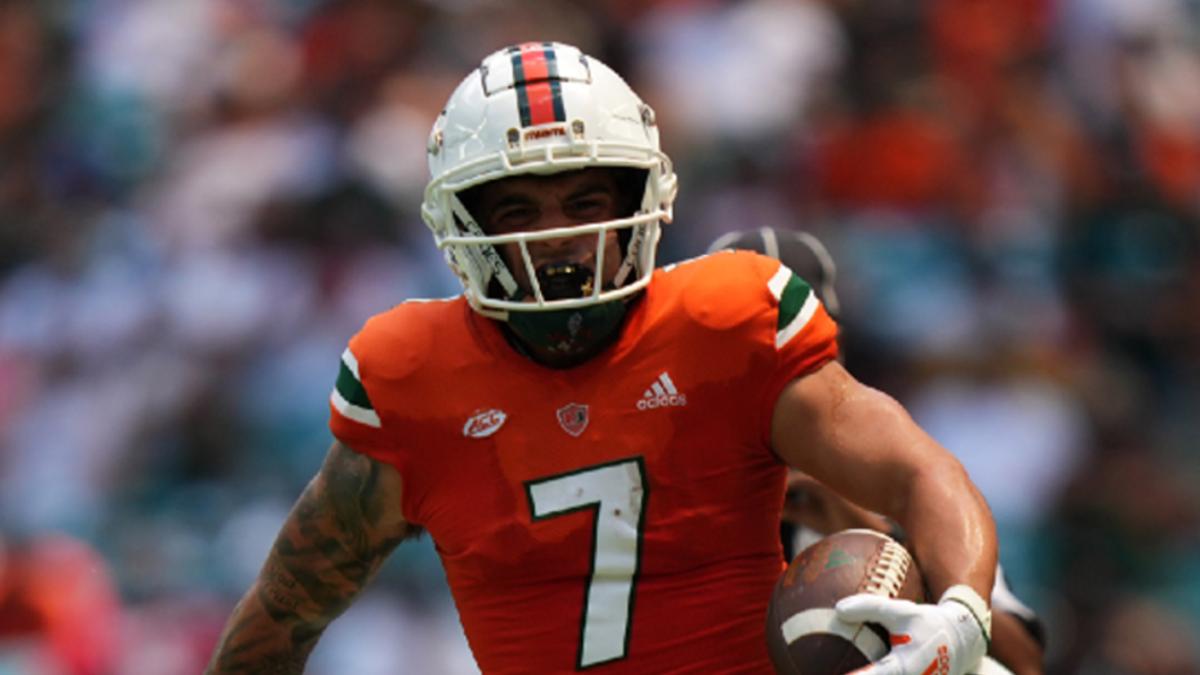Miami's Passing Game Must Create More Big Plays

The Miami Hurricanes' passing game is struggling and wide receivers Xavier Restrepo and Jacolby George are going through injuries to make matters worse.
Some want to blame quarterback Tyler Van Dyke and/or offensive coordinator Josh Gattis and/or head coach Mario Cristobal. That’s too simplistic. The passing attack for Miami, or any college football team, has several moving parts and solutions to fix issues within it.
Here are some valuable Van Dyke and receiving statistics to consider, as well as an analysis of what Miami can do to improve.
The raw passing numbers from Van Dyke: 55-of-87, 63.2%, 665, 7.6 yards per attempt, three touchdowns and two interceptions. Digging deeper, there is a significant difference when Van Dyke is being blitzed, according to Pro Football Focus statistics.
When there’s an upcoming blitzer, Van Dyke has completed 10-of-18 (55.6%) for 142 yards, a 7.9 average per attempt average, and no touchdowns or interceptions. While the completion percentage for being blitzed is solid, the yards per catch and touchdown number leave much to be desired.

Van Dyke and Miami must make teams pay for leaving the secondary exposed with fewer defenders. The good news is that Van Dyke has shown more consistency when not being blitzed.
He is 43-of-67 (64.2%), 529 yards, a 7.9 average per attempt, three touchdowns and one interception.
Because of how he’s performing well when not being blitzed, teams will inevitably come after Van Dyke more often. Along with the offensive line, Van Dyke needs to be ready for that outcome.
That’s especially true during those critical moments when it’s a one-on-one situation with a receiver and there’s a chance for a 20-plus yard gain. Even if he does not increase his completion percentage against the blitz, Van Dyke hitting a streaking receiver down the field can change the scoreboard and the outcome of a game.
Part of that issue is when being blitzed the offensive line sometimes fails to hold its end of the bargain and Van Dyke does not possess the time to survey the field and complete downfield shots. It is improving based upon the Texas A&M game, however.
There are bigger questions with the players attempting to catch passes from Van Dyke than those blocking for him.
Per Pro Football Focus and from the first three games, just five players have been targeted 11 or more times. Restrepo is one of them so that leaves the following four players listed with significant receiving statistics.
Brashard Smith: 11 targets, 10 receptions, 85 yards, 8.5 average and no touchdowns.
Will Mallory: 11 targets, eight receptions, 77 yards, 9.6 yards per reception, and no touchdowns.
Michael Redding III: 14 targets, eight receptions, 105 yards, 13.1 average, and one touchdown.
Key’Shawn Smith, 12 targets, six receptions, 91 yards, 15.2 average, and one touchdown.
The biggest takeaway from the above four would, once again, be the yards per catch average. At least Key'Shawn Smith is averaging over 15 yards per catch, and the coaching staff absolutely must find more ways to scheme up chances for him to catch deep passes to better utilize his speed.
He has a 35-yard reception this season but it’s honestly surprising that there’s not another big play from such a fast wide receiver.
For the record, the longest passing play of the season went to Restrepo for 52 yards. Someone must also start making up for his absence in the lineup.

Clemson transfer Frank Ladson, Jr. only has two catches for 33 yards. He’s going to have more chances to play with Restrepo and George out of the lineup.
Same with Romello Brinson. He has three catches for 28 yards. Brinson is another young receiver with a chance to show why he was a coveted high school prospect. The coaching staff also needs to find ways to help Ladson and Brinson improve, as well as the passing game overall.
More play-action passes could be one answer. Only 32 of 95 passing attempts, 33.7%, have been of the play-action variety. Increasing that percentage is one way to help get big passing plays to Key’Shawn Smith and other Hurricanes.
Speaking of throwing the football deep, it’s a bit surprising to see the data about Miami’s play-action passing game considering the rushing success. The Hurricanes are ranked as the No. 26 unit in the nation by averaging 219 yards per game, as well as 5.3 yards per carry.
Another point that could be important to elevate the Miami passing attack derives from the talent in the backfield being used differently in the passing game.
Running backs Henry Parrish, Jr. and Jaylan Knighton possess speed and playmaking ability. While screens are still a valuable commodity, getting them out into routes more often could lead to big passing plays.
Wheel routes, arrow routes, and even placing them in the slot and running a quick slant can all be opportunities to get them the football. After the ball is in their hands, natural running instincts can take over for Parrish and Knighton.
Finally, Miami’s overall execution within the passing game must improve. As boring as it may seem to discuss, Miami’s players have to execute play calls better. A small misstep in protection or how a receiver runs a route can lead to a blown chance for Van Dyke to connect with an intended target.
Van Dyke must throw strikes when there’s a chance for that big play, too. Some of the execution issues will likely improve with more and more time in the scheme Gattis has begun to implement. Hopefully, that’s sooner than later.
Let’s see how Miami attacks Middle Tennessee State (Sep. 24) and reconvene afterwards.
AllHurricanes.com is your home for all things Miami Hurricanes football, recruiting, basketball and other athletics, all the time. Follow along on social media at @AllHurricanes on Twitter and All Hurricanes on Facebook for round-the-clock news and analysis.
